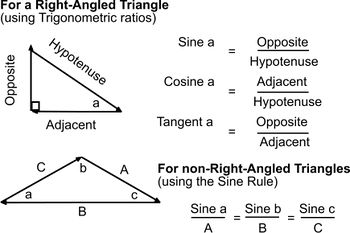Trigonometry: Difference between revisions
From DT Online
(Trigonometry) |
mNo edit summary |
||
| (4 intermediate revisions by the same user not shown) | |||
| Line 7: | Line 7: | ||
An exception is the [http://en.wikipedia.org/wiki/Law_of_sines '''Sine Rule'''] shown opposite which can be very helpful when determining the unknown forces in a '''Force Triangle''' for example. | An exception is the [http://en.wikipedia.org/wiki/Law_of_sines '''Sine Rule'''] shown opposite which can be very helpful when determining the unknown forces in a '''Force Triangle''' for example. | ||
[[Category:Secondary]] | |||
[[Category:Geometry]] | |||
[[Category:Terminology]] | |||
Latest revision as of 08:32, 3 June 2015
Trigonometric ratios are used to calculate angles and lengths of sides of triangles. Most commonly, the ratios relate to a right-angled triangle and are known as the Sine, Cosine, or Tangent of a given angle.
Trigonometry also exists for non-right-angled triangles but since a non-right-angle triangle can be bisected to create two right-angle triangles, most problems can be reduced to calculations on right-angle triangles.
An exception is the Sine Rule shown opposite which can be very helpful when determining the unknown forces in a Force Triangle for example.
